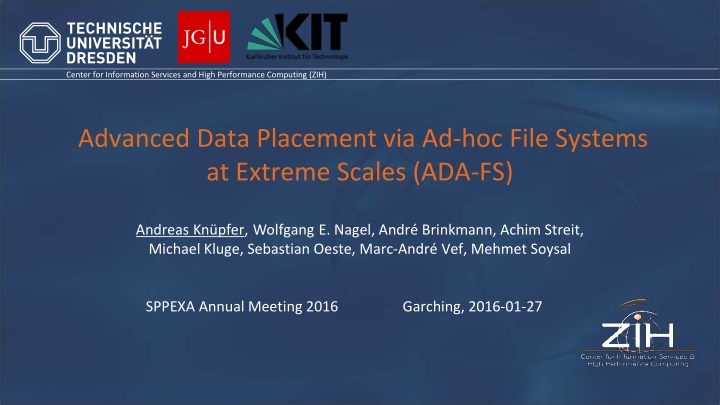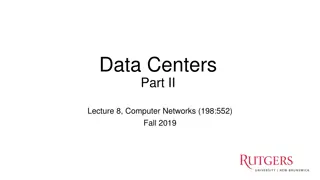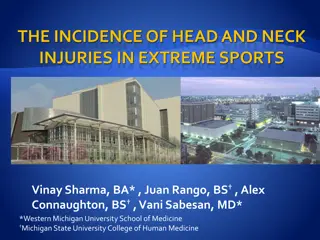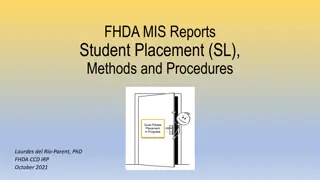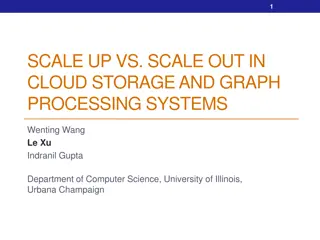Improving Extreme Scale Data Placement for High Performance Computing
Explore the challenges faced by I/O subsystems in HPC machines at Exascale, and the proposed solution of using an Ad-hoc overlay file system for optimizing I/O performance. The research aims to enhance data placement through transparent solutions for parallel applications by leveraging additional storage and early input staging. Emphasis is placed on efficient I/O planning, global coordination, and integration with batch scheduling systems.
Download Presentation

Please find below an Image/Link to download the presentation.
The content on the website is provided AS IS for your information and personal use only. It may not be sold, licensed, or shared on other websites without obtaining consent from the author.If you encounter any issues during the download, it is possible that the publisher has removed the file from their server.
You are allowed to download the files provided on this website for personal or commercial use, subject to the condition that they are used lawfully. All files are the property of their respective owners.
The content on the website is provided AS IS for your information and personal use only. It may not be sold, licensed, or shared on other websites without obtaining consent from the author.
E N D
Presentation Transcript
Center for Information Services and High Performance Computing (ZIH) Advanced Data Placement via Ad-hoc File Systems at Extreme Scales (ADA-FS) Andreas Kn pfer, Wolfgang E. Nagel, Andre Brinkmann, Achim Streit, Michael Kluge, Sebastian Oeste, Marc-Andre Vef, Mehmet Soysal SPPEXA Annual Meeting 2016 Garching, 2016-01-27
ADA-FS ADA-FS: Advanced Data Placement via Ad-hoc File Systems at Extreme Scales New project in the second funding period of SPPEXA Addressing SPPEXA topics: system software and runtime libraries data management Technische Universit t Dresden: PI Wolfgang E. Nagel, Andreas Kn pfer, Michael Kluge, Sebastian Oeste Johannes Gutenberg University Mainz: PI Andre Brinkmann, Marc-Andre Vef Karlsruhe Institute of Technology: PI Achim Streit, Mehmet Soysal
Project Rationale I/O I/O Challenges Challenges at at Exascale Exascale I/O subsystem is the slowest one in a HPC machine (bytes per flop, latency) Shared medium: no reliable bandwidth, no good transfer time predictions Upcoming architectures with fat nodes and intermediate local storages Goal: optimize I/O Goal: optimize I/O Faster access Using additional storages Transparent solution for parallel applications Pre-stage inputs early, cache outputs Pre-stage inputs
Background: Upcoming HPC Architectures Expected Exascale architectures and announced 100 PF machines: Orders of magnitude more processing units / compute power per node Local intermediate storages, must be used for decent I/O performance More complicated and machine-specific storage hierarchy Bandwidth perspective: # compute nodes N Global I/O bandwidth S Caching bandwidth C Break-even point N*= S/C SuperMUC / LRZ Phase 1 9400 200 GB/s (0.5 GB/s) 400 SuperMUC / LRZ Phase 2 9421+3072 250 GB/s (0.5 GB/s) 500 Titan / ORNL 18688 240 GB/s (0.5 GB/s) 480 Summit / ORNL (anounced) 3400 1 TB/s 1.6 GB/s (assumed) 625
Proposed Solution Ad-hoc overlay file system Separate overlay file system per application run Instantiated on the scheduled compute nodes From before the parallel application starts until after it finishes Central I/O planner Global Planning of I/O including stage-in/-out of data, for all par. jobs Optimization of data placement in the ad-hoc file system (resp. nodes) Integration with systems batch scheduler Application monitoring, resource discovery I/O behavior, machine-specific storage types, sizes, speeds,
Overlay FS Ad-hoc overlay file system: Parallel Application Process Monitor I/O operations Parallel Application Process I/O requests and responses Ad-hoc overlay FS (node local) Can modify or redirect I/O op. Parallel FS (node-local kernel module) Parallel FS (node-local kernel module)
Overlay FS Ad-hoc overlay file system: Overlay FS RAM SSD Ranks 0-7 Separate overlay file system per application run NVRAM HDD Instantiated on scheduled compute nodes Ranks 8-15 RAM SSD Overlay FS NVRAM HDD Allocate buffers in local storages Other compute node, not part of same job Ranks 16-23 RAM SSD Overlay FS NVRAM HDD Other compute node, not part of same job
Overlay FS Ad-hoc file system present from before the application starts until after it finishes Allow buffering beforehand/afterwards Buffer inputs Partition inputs Inputs for rank 0 All inputs Ranks 0-7 RAM SSD CPU NVRAM HDD Inputs for rank 7 Ranks 8-15 Inputs for rank 8 RAM SSD CPU NVRAM HDD Inputs for rank 15 Ranks 16-23 Inputs for rank 16 RAM SSD CPU Parallel FS NVRAM HDD Inputs for rank 23
I/O Planner Individual parallel jobs cannot optimize I/O performance Global parallel file systems are shared resources No bandwidth guaranties, no reliably I/O time estimations Central I/O planner schedules I/O operations Assume all parallel jobs are under control of ADA-FS Assume coarse-grained I/O behavior known: I/O phases and I/O gaps Allow I/O phases of running jobs with priority When stage-in inputs for future jobs? To which nodes? When stage-out outputs from past jobs? Integrate with job scheduling
Application Monitoring and Resource Discovery Application monitoring Monitor parallel applications, record I/O behavior Generalize I/O behavior for types of applications Predict I/O phases and I/O gaps Input for I/O planner Predict input partitioning Input for Overlay FS buffering Resource discovery and monitoring Discover machine-specific storage types, sizes, reliable local speed, Monitor resource allocations by parallel applications, determine what is left for local buffers Input for Overlay FS deployment Approach: start with explicit specifications, research automated solutions
Challenges and Benefits Restrictions Restrictions 1. Each file/object is only accessed by a single application, yet from many nodes at a time Restricted POSIX FS semantics as additional research topic 2. No ls -a type operations in the overlay FS 3. No communication via files type operations Practical benefits Practical benefits Applications will be required to use additional burst buffers for I/O Separation of concerns: decouple application logic from storage hierarchy Enable bandwidth guarantees and reliable timing predictions for I/O operations, when combined with central I/O planning
Consortium and Previous Work Wolfgang E. Nagel (Speaker), TU Dresden Parallel performance monitoring and I/O monitoring Flexible storage system design for local HPC infrastructure Andre Brinkmann, Johannes Gutenberg-Universit t Mainz Development of metadata server-free parallel file system Investigation of file system access traces to verify key assumptions 1 and 2 (both together with BSC) Achim Streit, Karlsruher Institut f r Technologie Job scheduling and resource management for HPC and distributed systems: planning, self-tuning, brokerage Large-scale data management
Work Plan WP 1: Ad WP 1: Ad- -hoc File System (led by JGU) hoc File System (led by JGU) Design ad-hoc overlay file system Deployment and synchronization with underlying global parallel file system Coordination between nodes WP 2: Planning (led by KIT) WP 2: Planning (led by KIT) I/O estimation and scheduling Integration with batch job scheduler Optimization of data placement WP 3: Discovery and Monitoring (led by TUD) WP 3: Discovery and Monitoring (led by TUD) Resource and Topology Discovery Dynamic Resource Usage Tracking Monitoring of ad-hoc FS behavior and of application I/O WP4: Integration and Demonstration (led by TUD) WP4: Integration and Demonstration (led by TUD)
Summary Project goals Project goals Improve I/O performance Adopt upcoming architectural features Transparent to application codes Steps Steps Design overlay file system Create central I/O planner Discovery, monitoring, learning I/O behavior Integration Demonstration at scale
